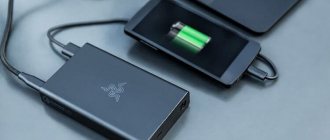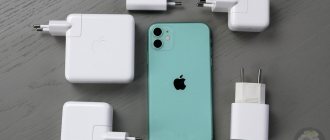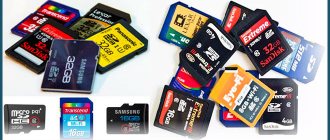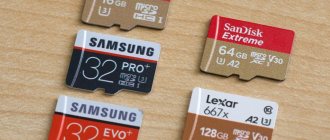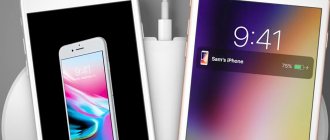Despite the recent increase in the internal memory capacity of phones, many users do not have enough space to store multimedia files so that they are always at hand. The cloud location may be unavailable due to poor 3G network coverage, so small micro CDHC and other types of storage devices that have large capacity and high data transfer speeds come to the rescue. Find out from the rating which are the best memory cards for phones, suitable for storing music, movies, cartoons, a large number of photos or work programs.
Why don't they put SD cards in smartphones today?
Have you ever wondered why most manufacturers have now begun to limit the ability to install SD memory cards? It all started with very profitable and profitable marketing by Apple. For example, a Micro SD card with a capacity of up to 16 or 32 GB could easily cost you up to 1000 rubles. That is, for this money you could get a card of a higher class, and this is regardless of the dollar exchange rate, which was then and now.
At the same time, the difference between devices with 16, 64 and 128 GB, if we are talking about the same Apple, is much larger, approximately $100 for each doubling of memory. That is, you add 100 dollars, and you already take a card for 64 GB, add another 100 dollars, and you already take it for 128 GB.
Approximately the same pricing policy applies to Apple and most companies that produce smartphones now. In particular, this applies to Samsung Galaxy. For many fans of the company, it was a complete surprise that they had recently abandoned installing an SD memory card in some of their smartphones. Moreover, you can observe that cheap smartphones still have this option with memory cards.
Types of sizes
If you are lucky and you own a smartphone that supports SD memory cards, then you need to decide which one you can install in it. First of all, decide on the form factor.
- SD cards are the largest cards, measuring 32x24 mm. They are mainly used in cameras and camcorders
- mini SD - medium-sized memory cards, they can also be seen installed in cameras or video recorders, but this form factor is very rare
- micro SD is the smallest memory card standard that has gained immense popularity for installation in small devices - phones, tablets, surveillance cameras, radios, speakers, etc.
Modern phones usually work with microSD cards, since due to their miniature size they take up little space inside the case.
Formats
So, we’ve decided that for a smartphone you need to choose from microSD cards; cameras and video cameras most often use regular SD cards. But that’s not all - among flash drives there is another division into categories based on the type of memory itself built into the device’s chip. The recording speed and data storage volume depend on them
- Secure Digital High Capacity (SDHC) is the most popular memory card format today, characterized by good speed and reliability. The only limitation that can stop it is the maximum supported volume - only 32 GB. If the smartphone has enough internal memory, then SDHC can be increased a little, and this will be enough. If the phone itself does not have such a large amount of internal storage, then it is better to look towards a different standard. Another nuance is the use of the FAT32 file system, which is characterized by the fact that the maximum size of one file should not exceed 4 GB. This places a limit on downloading high-definition movies weighing more than 4 GB.
- Secure Digital Memory Card (SDMC) is another fairly common format, which in its properties is very similar to SDHC. The same 32 GB maximum volume and 4 GB per document
- Secure Digital eXtended Capacity (SDHC) is the most technologically advanced memory card that supports large storage capacity (from 4 GB to 2 TB). At the moment, I would recommend using them, especially for recording video in high resolution, since the SDHC uses the exFAT file system, which limits the size of a single file to 256 TB, which is several times larger than the memory card’s own capacity. The only “but” is the price. SDHC memory cards are quite expensive, they are used in professional devices, and not everyone can afford them. Also, inexpensive smartphones may simply not have built-in support for this format.
Classes of SD cards by recording speed
All flash drives are divided into classes according to write speed. When choosing an SD memory card for your phone, focus on the highest class. In this case, you can easily record high-quality videos on it. Many manufacturers of car DVRs generally limit work with lower-level SD cards at the software level.
- SD 1.0 - from 8 MB to 2 GB
- SD 1.1 – up to 4 GB
- SD Class 2 - write speed of at least 2 MB/s - 13x
- SD Class 4 - write speed of at least 4 MB/s - 26x
- SD Class 6 - write speed of at least 6 MB/s - 40x
- SD Class 10 - write speed of at least 10 MB/s - 66x
Also, the speed value can be supplemented by the letter “V” and a number next to it, indicating the minimum recording speed.
- V6 (Class 6) - write speed from 6 MB/s
- V10 (Class 10) - from 10 MB/s
- V30 (Class 30) - from 30 MB/s
- V60 (Class 60) - from 60 MB/s
- V90 (Class 90) - from 90 MB/s
These are SD cards of an even higher level, and they are mainly used for recording high-definition video.
UHS
But this is not the limit. There are SDXC and SDHC SD memory cards with increased speed to perform the most speed-demanding tasks. Again, to record video in the highest resolutions available today. They are designated as “UHS”, which stands for “Ultra High Speed”, that is, ultra high speed.
There are two classes of cards that support UHS:
- U1 - guaranteed write speed from 10 MB/s
- U3 - guaranteed speed from 30 MB/s
The case of an SD card with UHS support will have a letter “U” with its class number.
To clarify the speed, there are also additional designations for the maximum recording speed:
- UHS I – write and read speeds up to 104 MB/s
- UHS II – up to 312 MB/s
microSD memory cards for DVRs
When DVRs are used, a more durable microSD memory card is required. You'll need something that can be written to over and over again with virtually no problems, such as a high-endurance card. Since video files are overwritten, this memory card will wear out over time. Some memory cards are more durable and designed to perform in these specific environments. Kingston offers a microSD card with increased write life and durability that can store up to three times more data than a regular microSD card. Be sure to look for a memory card that is specifically designed to be durable, and try to find a card that comes with a warranty, as the card will wear out over time.
How to determine the class and recording speed of an SD card?
We've sorted out the theory. Now let's imagine that we are in a store and using a real example, let's try to determine which SD card is in front of us.
What is your opinion: is WiFi harmful?
Yes
22.91%
No
77.09%
Voted: 36547
First of all, we look at the format - SDHC or SDXC. Below is an inexpensive SDHC memory card with a maximum capacity of 32 GB for this type. We also see that it has class 4, that is, a write speed of 4 MB/s. This option (only in micro SD version) is quite suitable for an inexpensive smartphone.
But below is a cooler map, it’s more difficult to understand the characteristics and there are more inscriptions. It also has SDHC format. And despite the smaller volume (16 GB), it is already class 10 with support for UHS-I (U1) with a write speed of 60 MB/s. This can already be used not only in a phone, but also for recording video in good resolution on a camera or camera.
And finally, the most advanced memory card in this collection of SDXC format 64 GB:
- Speed class - 10, V90
- UHS - 3, UHS II
- Read and write speed - 300 MB/s
The best manufacturers
When choosing a micro-SD, due to the huge assortment, the user may get confused. To make comparison easier, you can study the rating of the top options for memory cards for smartphones.
Rating by manufacturer:
- SanDisk Extreme microSDXC Class 10 UHS Class 3 – has impressive parameters, speed class – 10. It is also characterized by a read speed of 160 MB/s, recording playback at 90 MB/s. Options are available with memory capacities from 32 to 512 GB.
- Kingston SDCS2/32GB – corresponds to the microSDHC format. Compatible with any devices running Android OS. Read speed – 100 MB/s, write speed – 85 MB/s. Files are transferred to the device quickly.
- Samsung EVO Plus MB-MC64GA – suitable for most digital equipment. Long videos are recorded on it. The card records and plays files without interruption.
In the digital technology market, not only brands of flash cards from well-known global manufacturers, but also Chinese copies have strengthened and taken leading positions. For example, Xiaomi memory cards are in no way inferior in technical characteristics and performance to their South Korean and American counterparts.
Using SD cards in smartphone memory
Let's return to the practice of using SD in smartphones. A fairly advanced class 10 memory card means that its speed will be about 10 Mbit/s. This is not small, but it is significantly less than the speed of reading and writing the internal memory of the same new Samsung Galaxy or iPhone.
This is why many manufacturers have stopped providing the ability to install SD memory cards in their phones, because many people install the cheapest models with the largest capacity they can find. As a result, it really turns out that the reading speed from them is significantly lower than from the built-in drive.
By purchasing, for example, a Samsung or an iPhone for a little less than 100,000 rubles, a person saves on a very basic memory card. That is, for example, the XC standard does not suit him. He doesn’t want to overpay for 64 GB of memory card, and it will be even more difficult to convince him that he needs higher speed.
If we draw an analogy with Compact Flash memory cards, then the difference between them can generally vary up to 5 times. For example, we take a Compact Flash 133 memory card and a Compact Flash 1067 memory card. If we are talking about conditional 64 GB, then a 133 card can be purchased at a price of about 4000-4500 rubles maximum, and 64 GB for 1067 can even be taken for 10,000 rubles difficult. Although the difference can be even greater, and it is due to speed.
But those people who take SD memory cards at such speeds understand why. For example, in order to record video in Apple Pro Resolution, that is, in a codec that practically does not use compression and allows you to record in the format of the most rich color correction. Photographers can draw an analogy to what it means to shoot in RAW format. Anyone who has ever shot in RAW format with their camera will not shoot in any other format. And to work with it, you need to install a high-quality SD card in the camera.
The main problem is that most people buy the cheapest SD memory card. And as a result, then from time to time everything in their smartphone slows down, and they begin to scold it. Now there are a huge number of smartphones with 4K video recording, for example the iPhone. Let's imagine what would happen if there was a memory card in it?
Surprisingly, those who buy the latest iPhone models are not mostly people who do not make very good money. This is due to the fact that there is an absolute majority of poor people, and much less rich people. Imagine that a person takes out a 32 GB iPhone on credit and at the same time inserts an SD card into it. But since he doesn't have much money, he saves and takes a low-end memory card. Do you really think it will really be enough to record 4K video?
Where are memory cards used?
Some manufacturers of mobile gadgets do not use a slot, immediately installing a certain amount of space in the device, while others provide a minimum of built-in memory so that users can independently add as many GB as they need to store information.
Printers
Some manufacturers install memory card readers in the printer so that the photo from the camera can be printed immediately, without the need to transfer data from the computer. It takes a long time to find a cord to connect, so an alternative method is used. Such models are often used in companies that offer express photo printing in 10-15 minutes.
Video cameras and cameras
Although compact cameras have built-in memory, it is worth expanding it with a card with standard data storage and transfer speeds. This will allow you to take hundreds or thousands of photos without worrying about running out of space. With SLR cameras, you should choose a high-capacity card of the highest class, which will allow you to store large bursts of photographs.
On a note!
If the computer does not have a connector, you need to buy a special reader that supports as many formats as possible and connects to the PC via USB. This is a faster way to transfer data than connecting the camera via a cable provided by the manufacturer.
Feature phones and tablets
Memory cards are used not only for smartphones, but also for regular phones. MicroSD media allows you to store photos, mp3 files or movies. Inexpensive models can be used as MP3 players after installing a card of a suitable size. In tablets, a large memory card capacity is needed to install applications and store e-books, movies, and music.
Which memory card should I choose for my phone?
So, if you have a phone, DVR or camera with decent specs, then splurge on a good SD memory card! Get a memory card with the fastest speed you can get. There is the HC standard and the XC standard, which has the ability to install larger memory cards - up to 200 GB. But if you don’t have the money, then it’s even better to take a smaller volume, but a higher recording speed.
There are a lot of marketing ploys now, so when purchasing a memory card for your camera, smartphone or DVR, you should definitely check the reading speed.
No matter what is written, no matter what tricks the manufacturer writes, such as: ultra, super, superspeed, turbo, you must objectively look at the read and write speeds.
What to look for when purchasing
The ease of use of the gadget depends on the choice of card type based on the main performance characteristics. Models of the same format may differ significantly from each other in parameters. Selected technical data should also be analyzed before purchase. Be sure to take into account the advice of sellers, they will tell you the best choice.
Capacity
It is better to buy cards with the highest capacity, the price of which falls within your available budget. This is especially true for owners of cameras or cameras, whose memory fills up very quickly. In some cases, you can buy two or three smaller capacities so that in the event of a failure, all available data is not lost.
Data transfer rate
For cameras and DSLRs, you need to choose high-speed Type A cards. It is worth noting that manufacturers use different speed classes for the same type. This parameter may also depend on the device, so before purchasing, you need to check the maximum data transfer capacity of your tablet, camera or smartphone.
Manufacturer
To store important data, it is better to buy a card made by one of the well-known brands. Counterfeits or devices from unknown companies may not only be slower, but also more susceptible to damage and various types of failures. When purchasing, be sure to check whether there is a certificate and a warranty card for 6-12 months.
Popular companies that produce cards:
- SanDisk;
- Kingston;
- Transcend.
Manufacturers also offer adapters in their range. MicroSD and microSDHC cards, that is, smaller memory sizes, can be used in devices that support full-size media. To make this possible, you need an adapter where the micro card fits.
Choosing a speed class for a budget smartphone
Before we start, I would like to remind you that not every phone will be able to “pull” a flash card with a large amount of memory.
Let's say your phone has a camera of about 5 megapixels, and you most often use basic functions (such as calls and SMS), some applications, and only occasionally take pictures. Then a flash card up to Class 4 is enough for you.
Especially if the gadget does not support SDHC and SDXC volumes.
For example, the Lenovo A1000 smartphone on the Android platform has a 5 MP camera, which does not require high data transfer speed. Class 2 will be enough for him and other gadgets with similar characteristics; if you intend to actively use the Internet and applications – 4th.
Type and form factor
The first memory cards appeared back in the 90s and since then they have been actively developed. In particular, more than a dozen different types of memory cards have appeared, which were developed by different companies and are intended for different purposes. For example, now on sale you can find such types as CompactFlash I (CF-I), CompactFlash II (CF-II), Memory Stick (MS), MultiMedia Card (MMC), Secure Digital card (SD), Universal Flash Storage (UFS ), xD-Picture Card (xD), etc.
Therefore, when choosing a memory card for a smartphone or telephone, it is very important not to make a mistake with the type of card. Nowadays, absolutely all smartphones and phones use memory cards of the Secure Digital card type (abbreviated as SD). This type is the most common and is used in many other mobile devices that require data recording. For example, SD cards are used in video cameras, car DVRs, GPS navigators, cameras, e-readers and game consoles. SD readers are also often found in laptops and desktop computers.
One of the features of Secure Digital (SD) is the presence of three form factors. In addition to full-size SD cards, there are also two smaller versions called miniSD and microSD. Full-size SD cards are typically used in camcorders, cameras, and other large equipment. And in smartphones, phones and other mobile devices they use the most compact version called microSD (11 x 5 x 1.0 mm).
All three form factors of Secure Digital memory cards are compatible with each other. Therefore, there are adapters that allow you to install smaller cards into slots for larger cards. This allows you to easily connect microSD from your smartphone to an SD card reader in your laptop or computer.
So when choosing a memory card for a smartphone or phone, you should immediately focus your attention on microSD. Smartphones and mobile phones require this type of memory.


